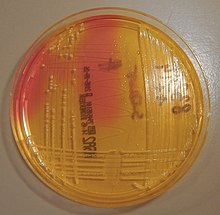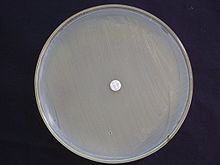MRSA
 Powiększenie 20 tys. razy z elektronowego mikroskopu skaningowego | |||
| Systematyka | |||
| Domena | bakterie | ||
|---|---|---|---|
| Typ | Firmicutes | ||
| Klasa | Bacilli | ||
| Rząd | Bacillales | ||
| Rodzina | Staphylococcaceae | ||
| Rodzaj | Staphylococcus | ||
| Gatunek | Gronkowiec złocisty | ||
| Podgatunek | MRSA | ||
| Nazwa systematyczna | |||
| Staphylococcus aureus F. J. Rosenbach, 1884 | |||
| Synonimy | |||
| |||
 | |
| ICD-10 | U80.1 Czynnik zakaźny oporny na metycylinę |
|---|---|


Gronkowiec złocisty oporny na metycylinę, MRSA (ang. methicyllin-resistant Staphylococcus aureus)[1] – oporne na metycylinę szczepy gronkowca, będące częstą przyczyną zakażeń wewnątrzszpitalnych. Stanowi on poważny problem finansowy dla ochrony zdrowia[2]. Wykształcony przez drobnoustroje typ oporności oznacza brak wrażliwości na wszystkie antybiotyki z grupy beta-laktamów – w tym penicyliny, cefalosporyny, monobaktamy czy karbapenemy.
Oporność nie polega na syntezie enzymów rozkładających lek (co nie oznacza, że bakterie takiego nie wytwarzają), ale nowego białka wiążącego antybiotyk – tzw. PBP. Zmienione białko PBP nie wykazuje powinowactwa do beta-laktamu. Opisano pięć genów syntetyzujących różne nowe białka PBP, dlatego ten typ oporności charakteryzuje się heterogennością. Szczepy MRSA są oporne na wszystkie antybiotyki β-laktamowe, a w 90% występuje ponadto krzyżowa oporność z makrolidami oraz fluorochinolonami. Jeżeli bakteria jest częściowo oporna na tę grupę antybiotyków, ale można je leczyć podając maksymalne dawki, używa się terminu MISA.
Leczenie i zapobieganie
Spośród środków doustnych wobec szczepów MRSA aktywność zachowuje sulfametoksazol, trimetoprim oraz linezolid[3]. Ze względu na częstą oporność, użycie klindamycyny oraz fluorochinolonów jest dyskusyjne[3].
Ogromną rolę w zapobieganiu transmisji bakterii odgrywa dokładne mycie rąk[4][5].
Pojawianie się szczepów MRSA wiązane jest z częstszym występowaniem owrzodzeń skóry[6]
Zobacz też
- VRSA – gronkowiec złocisty oporny na wankomycynę
- VISA – gronkowiec złocisty ze zmniejszoną wrażliwością na wankomycynę
- MRCNS – koagulazoujemne szczepy gronkowców opornych metycylinę
- MSSA – gronkowiec złocisty wrażliwy na metycylinę
- PSSA – gronkowiec złocisty wrażliwy na penicylinę
- MRSE
Przypisy
- ↑ Alternatywne nazwy: multi-resistant Staphylococcus aureus (MRSA; gronkowiec złocisty oporny na wiele leków), oxacillin-resistant Staphylococcus aureus (ORSA; gronkowiec złocisty oporny na oksacylinę)
- ↑ Clements A., Halton K., Graves N., Pettitt A., Morton A., Looke D., Whitby M. Overcrowding and understaffing in modern health-care systems: key determinants in meticillin-resistant Staphylococcus aureus transmission.. „Lancet Infect Dis”. Jul;8. 7, s. 427-34, 2008. DOI: 10.1016/S1473-3099(08)70151-8. PMID: 18582835.
- ↑ a b Powell JP., Wenzel RP. Antibiotic options for treating community-acquired MRSA.. „Expert Rev Anti Infect Ther”. Jun;6. 3, s. 299-307, 2008. DOI: 10.1586/14787210.6.3.299. PMID: 18588495.
- ↑ Weber CJ. Update on methicillin-resistant Staphylococcus aureus (MRSA).. „Urol Nurs”. Apr;28. 2, s. 143-5, 2008. PMID: 18488593.
- ↑ Romero DV., Treston J., O'Sullivan AL. Hand-to-hand combat: preventing MRSA.. „Nurse Pract”. Mar;31. 3, s. 16-8, 21-3; quiz 23-5, 2006. PMID: 16518193.
- ↑ Adam J. Singer, David A. Talan. Management of Skin Abscesses in the Era of Methicillin-Resistant Staphylococcus aureus. „N Engl J Med”. 370, s. 1039-47, 2014. DOI: 10.1056/NEJMra1212788.
![]() Przeczytaj ostrzeżenie dotyczące informacji medycznych i pokrewnych zamieszczonych w Wikipedii.
Przeczytaj ostrzeżenie dotyczące informacji medycznych i pokrewnych zamieszczonych w Wikipedii.
Media użyte na tej stronie
Autor: (of code) -xfi-, Licencja: CC BY-SA 3.0
The Wikispecies logo created by Zephram Stark based on a concept design by Jeremykemp.
The Star of Life, medical symbol used on some ambulances.
Star of Life was designed/created by a National Highway Traffic Safety Administration (US Gov) employee and is thus in the public domain.Magnified 20,000X, this colorized scanning electron micrograph (SEM) depicts a grouping of methicillin resistant Staphylococcus aureus (MRSA) bacteria. See PHIL 617 for a black and white view of this image. These S. aureus bacteria are methicillin-resistant, and are from one of the first isolates in the U.S. that showed increased resistance to vancomycin as well. Note the increase in cell wall material seen as clumps on the organisms’ surface.
An example of Petri dishes cultures of Staphylococcus aureus
This 2005 colorized scanning electron micrograph (SEM) depicted numerous clumps of methicillin-resistant Staphylococcus aureus bacteria, commonly referred to by the acronym, MRSA; Magnified 4780. Recently recognized outbreaks, or clusters of MRSA in community settings have been associated with strains that have some unique microbiologic and genetic properties, compared with the traditional hospital-based MRSA strains, which suggests some biologic properties, e.g., virulence factors like toxins, may allow the community strains to spread more easily, or cause more skin disease. A common strain named USA300-0114 has caused many such of outbreaks in the United States. See PHIL 10045 for a colorized version of this image.
- Methicillin-resistant Staphylococcus aureus infections, e.g., bloodstream, pneumonia, bone infections, occur most frequently among persons in hospitals and healthcare facilities, including nursing homes, and dialysis centers. Those who acquire a MRSA infection usually have a weakened immune system, however, the manifestation of MRSA infections that are acquired by otherwise healthy individuals, who have not been recently hospitalized, or had a medical procedure such as dialysis, or surgery, first began to emerged in the mid- to late-1990's. These infections in the community are usually manifested as minor skin infections such as pimples and boils. Transmission of MRSA has been reported most frequently in certain populations, e.g., children, sports participants, or jail inmates.
Muller Hinton agar with 4% NaCl showing a lawn culture of Staphylococcus aureus (MRSA)that is resistant to oxacillin disk (1 μg).





